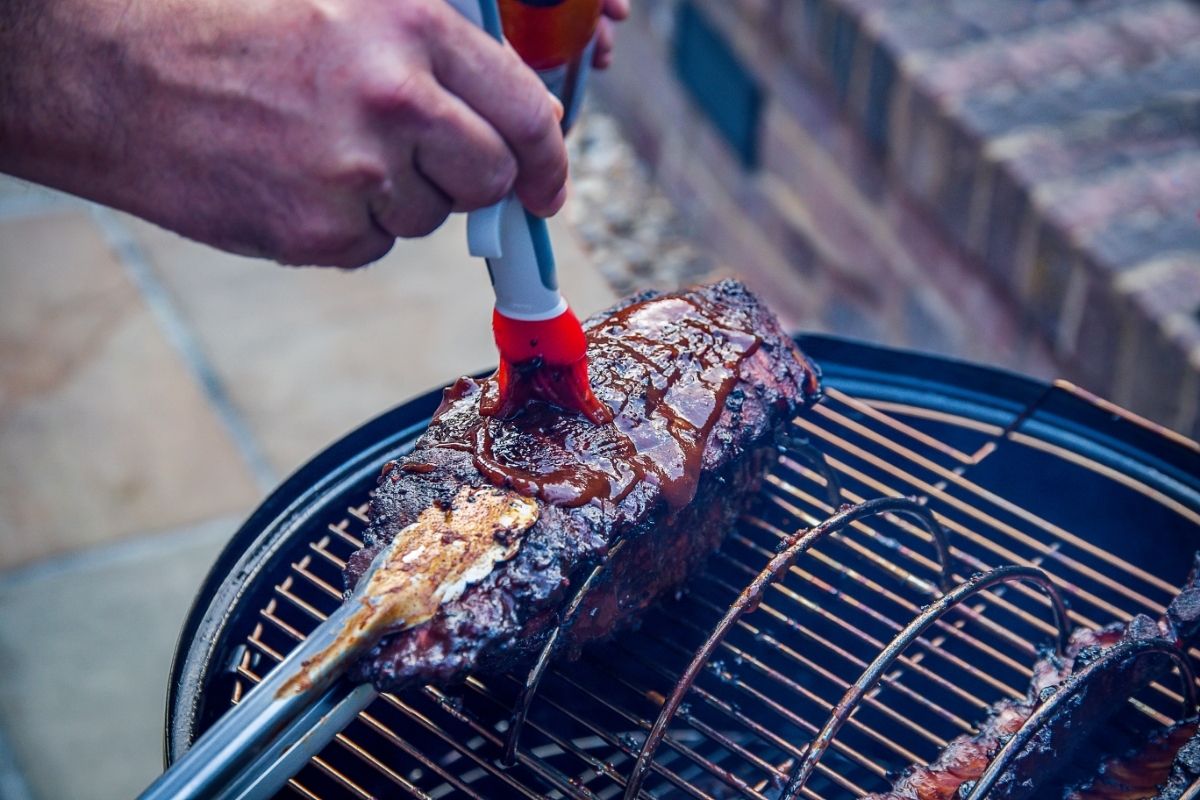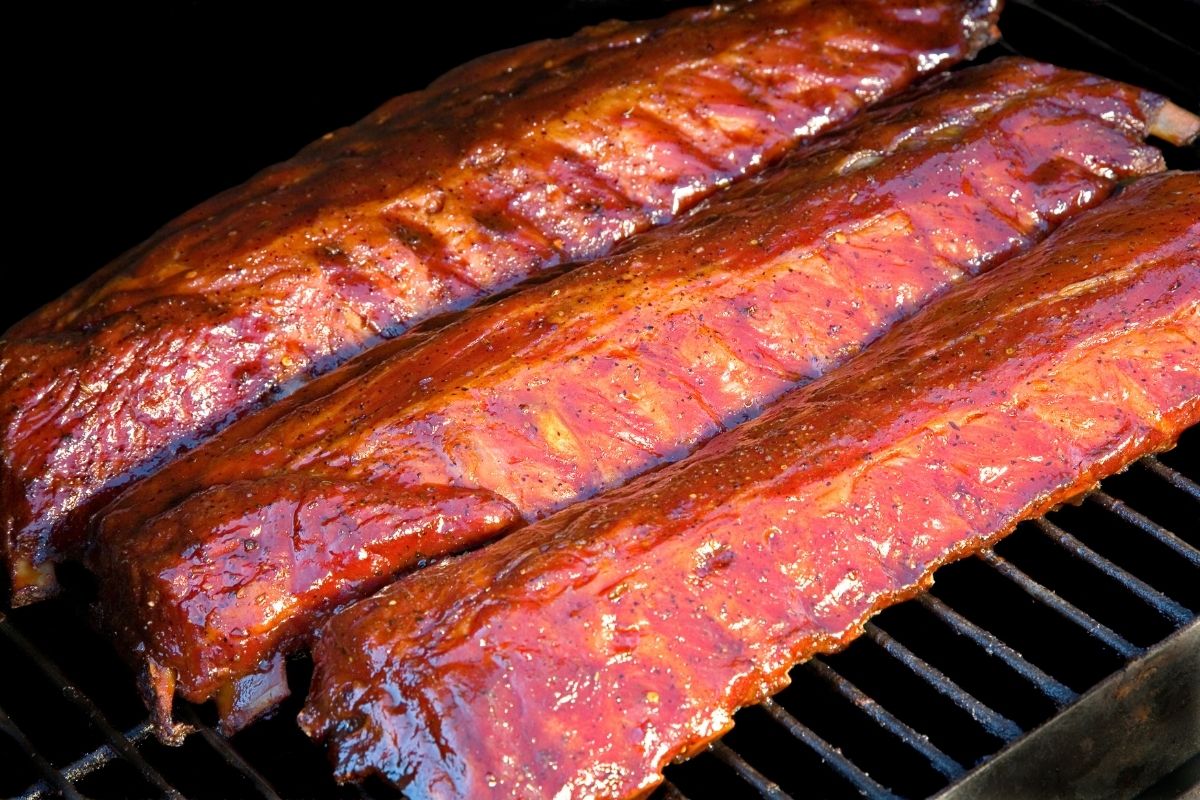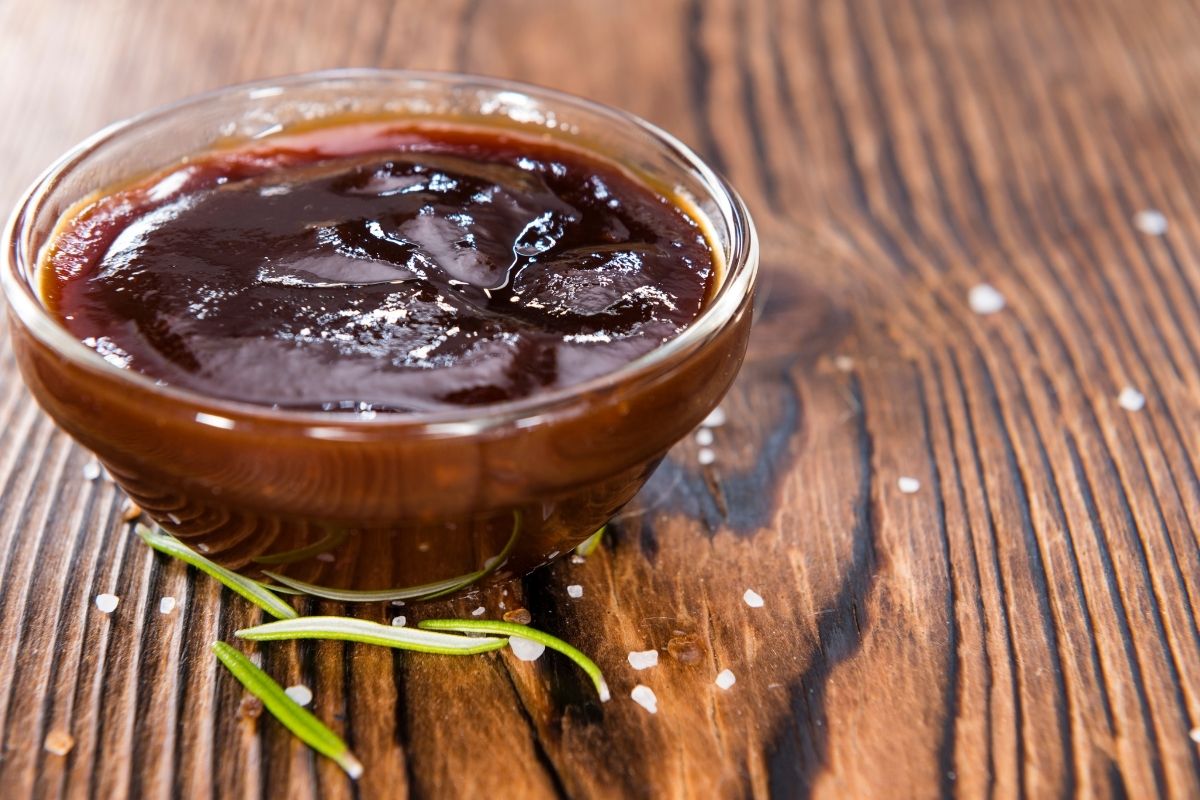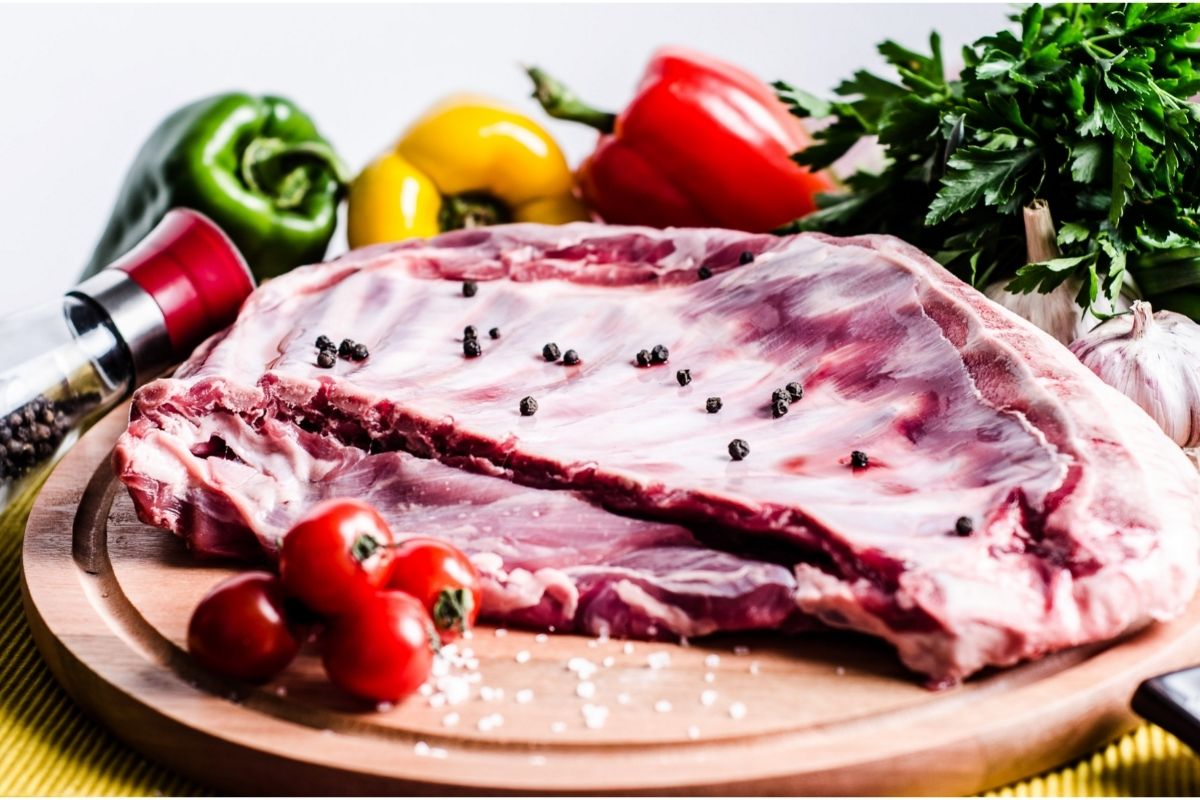There are three stages of smoking a rack of Pork Baby Back Ribs. Starting with the hours spent smoking them unwrapped to the next few hours they are spent wrapped in foil then returned to the smoker.

Finally, there is the remaining hour when you can remove the foil and complete the cooking.
How long you spend smoking the rack of ribs initially and what you do to them in the final hour is crucial to how well they turn out.
In this guide, we will look at why you should use the ‘2-2-1’ method instead of ‘3-2-1’ and what you can do to enhance the flavor of those tender ribs.
The Reasoning Behind The ‘2-2-1’ Method Of Cooking Baby Back Ribs
The ‘2-2-1’ term is a well-known shorthand for grillers who seriously enjoy their Pork Baby Back Ribs.
The ‘2-2-1’ method essentially means that the ribs are smoked uncovered for an initial two hours then wrapped in foil for another two hours.
It is the initial smoking time that causes consternation amongst the barbecuing community as some swear that the meat should fall off the bone and insist on three hours of smoking as opposed to two.
There is some leeway with the ‘2-2-1’ method as larger racks of ribs will need a longer cooking time. In that sense, the ‘2-2-1’ can be used as a ratio and not defined times.
Then again, if the temperature in the smoker dips then you will have to adjust the times accordingly anyway.
Why You Should Not Use The ‘3-2-1’ Method For Cooking Baby Back Ribs?

Many argue against the ‘2-2-1’ method and insist on the extra hour for unwrapped smoking for their Pork Baby Back Ribs.
Many recipes advocate this method and tend to end with the meat falling off the bone. That may seem ideal but is also another way of determining that the ribs are overcooked.
That’s right, you may have overdone a rack of Pork Baby Back Ribs instead of giving them the optimum treatment.
Take yourself to a barbecue competition and check out the Pitmasters ribs. Note how when the ribs are cut, the meat decidedly remains on the bone even when they bite into them?
That is the sign of expertly cooked Pork Baby Back Ribs, not the meat falling off the bone. Gravity should not be doing the hard work and the meat should stay in place.
Adding another hour to the two you spend initially smoking the ribs not only adds to the eventual cooking time but can be deemed excessive.
Especially when you consider the next two hours of being cooked in foil.
Perhaps if the time cooking the already smoked ribs in foil was reduced then the method could prove successful, as long as the pork meat is not falling off the bone.
While the ‘3-2-1’ method may not be ideal for Pork Baby Back Ribs, it may be just right for St. Louis-style Ribs and Spare Ribs.
These types of ribs simply need a bit more time to allow the connective tissue and delicious fat to sufficiently break down before they are cooked more gently when wrapped in foil.
Which Wood Should I Select For Smoking Pork Baby Back Ribs?
For any type of ribs, you should choose a wood that has a mild flavor when smoking them. As you gain confidence in grilling, you may find a wood with a flavor profile that works for you and your guests.
However, if you are a smoking novice then you can start with a mild flavor and then progress from there. Pork Back Baby Ribs also require a lighter touch with the wood as you do not want it to dominate your delicious meat.
Good choices for wood to use for smoking Pork Baby Back Ribs include apple, cherry, and pecan as the subtle flavors work incredibly well.
For a sweeter tinge, go for maple wood pellets or chips. Woods to avoid include hickory and mesquite as these would certainly be considered too strong, even to the extent of making your ribs taste bitter.
What Ingredients Should I Use For The Meat Rub-On Baby Back Ribs?
A single rack of Pork Baby Back Ribs should be treated with an expertly balanced meat rub. The ingredients should already be in your kitchen cupboard so there should be little need to head to the shops.
For an impromptu barbecue, that can be ideal to have in a recipe.
Start with a quarter-cup of soft brown sugar then mix in a tablespoon of Kosher salt to form the basis of your meat rub. The flavor comes from the spices and herbs that come next.
These include a tablespoon of paprika then two teaspoons each of garlic powder, onion powder, and ground ginger. The final ingredients are half a teaspoon each of oregano, black pepper, and cayenne pepper.
Do not forget to give it a good stir then apply it evenly on both sides of the ribs. For the best penetration of flavors, leave the rub on overnight so it has found its way into the meat.
Each Pork Baby Back Rib should be tender and with this meat rub, you can make each one delicious too.
When Should You Add Barbecue Sauce To A Rack Of Pork Baby Back Ribs?

Barbecue sauce can be added to a rack of Pork Baby Back Ribs during the final hour or half-hour of your total cooking time.
This is largely because a lot of the commercially prepared and common store-bought barbecue sauces use so much sugar that the sauce effectively burns when faced with heat.
Burnt sugar almost inevitably gives a rack of ribs a bitter flavor which is not what you want.
Part of the secret of smoking meat is to be patient with it. In this case, applying the barbecue sauce should be considered as a final step in the process.
Certainly, most of the cooking should already have been completed by the time you add any sauce.
You may not even want to add barbecue sauce to your rack of ribs as it may not be to everyone’s taste and the meat rub will do. In that case, leave the bottle of barbecue sauce on the table for guests to use as they want to.
How To Use Mustard With Pork Baby Back Ribs
Another flavor you may want to incorporate with your Pork Baby Back Ribs is mustard.
We may have enjoyed a steak with a dollop of mustard from time to time yet the taste of yellow mustard can work well with Pork Baby Back Ribs too.
Yes, it can be somewhat acrid yet the sticky consistency can help your meat rub stick when you add the rack of ribs to your smoker.
The last thing you want is for that expert mix of herbs, spices, and sugar to fall off onto your cooking grates.
You should also be relieved to know that the occasional overpowering taste of mustard does wear off during the extensive cooking process.
The mustard may even become so subtle you might not even notice it, apart from how the meat rub has stuck so well to the meat.
It does not have to be expensive mustard either as a plastic container of store-bought yellow mustard (the type you squirt on hot dogs) would perform admirably.
How To Cook A Rack Of Ribs Using The ‘2-2-1’ Method
Preparation is crucial with any cooking and your first step should be to remove any membrane from the rack of ribs.
You also have the choice of trimming the excess fat though you can keep some on if you want. Next, rinse the ribs under cold water then pat it dry using a few paper towels.
Now you can get the smoker going and set it to 225°F with a mildly flavored wood such as apple, cherry, pecan, or maple in the form of pellets.
If you are using a charcoal grill then you leave one side of the grill’s chamber free of coals and then build a low to medium-sized fire.
As the heat increases to your desired temperature, you can start to move the rack of ribs to the indirectly heated section.
With the rack of ribs cooking, you can create your meat rub using soft brown sugar, Kosher salt, and a range of herbs, spices, powders, and peppers.
You need some form of an adhesive to stick the meat rub to your rack of ribs and yellow mustard should do the trick. Spread on a thin layer then apply your rub to fully coat those ribs.
With your set of ribs covered, you can place them in the smoker but ensure that they are bone side down before you lock them in.

Give them two hours to smoke uncovered then get ready for the next two hours by getting out a sheet of aluminum foil (perhaps two if the foil seems a bit thin and too lightweight).
Remove the rack of ribs from the smoker then place them on the foil and ensure they are bone side facing down. Enclose the rack of ribs in the foil and ensure that there is a tight seal before you return them to the smoker.
After those two hours have elapsed you can try the ‘bounce test’ and as long as there are cracks by the bone when you bounce them, that should indicate that those hours of smoking have done the trick.
Now there are two more hours of cooking time which is the middle two in the ‘2-2-1’, after which the meat should slice off the bone.
To test that, if you feel any resistance from a toothpick that is put between the ribs then they probably need a bit longer.
Once ready, remove the rack of ribs from the smoker and unwrap them. There may be some steam so ensure that your hands and face are protected but also make sure that the juices are kept in.
With the foil taken off, you can put the ribs back in the smoker for their final hour.
At this point, you can decide how you best want to present your rack of ribs. You can baste them with the meat juices or turn up the heat to 350°F for a crispy finish.
A layer of barbecue sauce can also be added, ideally in the last thirty minutes. Do ensure you give them the requisite 10 to 15 minutes of resting before serving.
Final Thoughts
With only one hour, you make a formidable difference in how a rack of Pork Baby Back Ribs comes out.
While a lot of grilling experts will protest that three hours is ideal for smoking at the start, you do not want the meat to be falling off the bone.
Though you should exhibit patience, going for ‘2-2-1’ still gives you control by applying the bounce test and testing for doneness with a toothpick.
- The 9 Best BBQ Grills for Smoking Brisket - December 29, 2022
- 6 Mouth Watering Grilled Shrimp Recipes - September 16, 2022
- 6 Delicious Grilled Desserts - September 16, 2022
